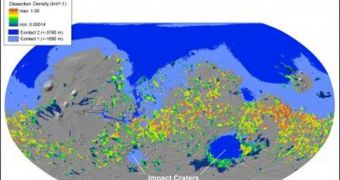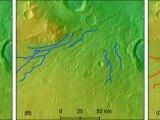Scientists at the Northern Illinois University (NIU) have recently announced that they managed to develop a new computer-generated map of the Red Planet, which adds more proof to the theory that claims a liquid ocean of water once existed on Mars. The team collaborated with colleagues from the Lunar and Planetary Institute, in Houston, in compiling the new body of pieces of evidence, which shows features twice as large as those discovered in previous investigations of those particular areas.
The innovative computer model would seem to suggest that the valley networks are at least 2.3 times longer than previous planet-wide maps of the structures let scientists believe. According to the same model, the regions of Mars that were cut by these valleys the deepest actually formed somewhat of a circle around a region that stretched between the equator and the mid-southern latitudes. All of this data is in tune with the idea that, at one point in our neighbor's distant history, its surface was covered by a large ocean that covered a big area. The potential ocean was located in the Northern Hemisphere.
“All the evidence gathered by analyzing the valley network on the new map points to a particular climate scenario on early Mars. It would have included rainfall and the existence of an ocean covering most of the northern hemisphere, or about one-third of the planet's surface,” NIU geography Professor Wei Luo explains. He is the author of a new study detailing the find, together with LPI staff scientist Tomasz Stepinski.
“The presence of more valleys indicates that it most likely rained on ancient Mars, while the global pattern showing this belt of valleys could be explained if there was a big northern ocean,” Stepinski reveals. Details of the team's work have been published in the latest issue of the respected Journal of Geophysical Research – Planets. Once, the team says, the planet was a lot warmer and wetter than it is today, which may explain the rainfall and the existence of the ocean. “It is now difficult to argue against runoff erosion as the major mechanism of Martian valley network formation,” Luo adds.
“When you look at the entire planet, the density of valley dissection on Mars is significantly lower than on Earth. However, the most densely dissected regions of Mars have densities comparable to terrestrial values. The relatively high values over extended regions indicate the valleys originated by means of precipitation-fed runoff erosion – the same process that is responsible for formation of the bulk of valleys on our planet,” the expert concludes.

 14 DAY TRIAL //
14 DAY TRIAL // 
